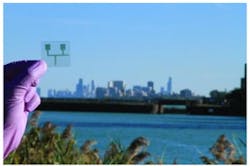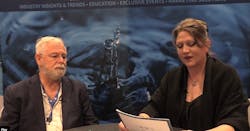| Commercial strip of glass covered with a film of 'hairy' nanoparticles, a kind of a 'nano-velcro,' that can be dipped into water to measure mercury levels. Photo: The Grzybowski Group, Northwestern University |
Using the device invented by the Swiss-American team, measuring the mercury levels in water or dissolved fish meat is as simple as dipping a strip of coated glass into the fluid. Metals and metallic molecules, such as methyl mercury, typically become positively charged ions in water. When these ions drift between the hairy nanoparticles, the hairs close up, trapping the pollutant. Passing a current over the strip of glass reveals how many ions are caught in the "nano-velcro." Each ion allows the strip to conduct more electricity.
U-M researchers Hao Jiang and Sharon Glotzer, the Churchill Professor of Chemical Engineering, performed computer simulations that investigated how the nano-velcro traps pollutants. They showed that the hairy nanoparticles are choosey about which ions they capture, confirming that the strips can give reliable measures of specific toxins as demonstrated by the experimental findings of the Swiss group.
"By making detection of pollutants and toxins cheap and easy to do, more testing at the source will lead to safer foods on the dinner table and in kids' lunchboxes," Glotzer said.
The scientists targeted particular pollutants by varying the length of the nano-hairs. This approach is especially successful for methyl mercury, and the device can measure it with record-breaking accuracy, detecting concentrations as low as 600 methyl mercury ions per cubic centimeter of water. Fortunately, that level of precision won't break the bank. The researchers estimate that the coated glass strips could cost less than 10 dollars each, while the measurement device will cost only a few hundred dollars. It could gauge the concentration of metals onsite and within minutes.
The researchers tested their method in Lake Michigan, near Chicago.
"The goal was to compare our measurements to FDA measurements done using conventional methods," Stellacci said.
Despite the industrial activity in the region, mercury levels were extremely low, in agreement with the FDA's analysis. The team also tested a mosquito fish from the Everglades.
"We measured tissue that had been dissolved in acid. The goal was to see if we could detect even very minuscule quantities," said Bartosz Grzybowski, the K. Burgess Professor of Physical Chemistry and Chemical Systems Engineering at Northwestern University, noting the species is too low on the food chain to accumulate high levels of mercury.
The United States Geological Survey reported near-identical results after analyzing the same sample.
"With this technology, it will be possible to conduct tests on a much larger scale in the field, or even in fish before they are put on the market," said researcher Hyewon Kim, MIT student visiting EPFL.
Funding for this research came from ENI, via the ENI-MIT Alliance; the U.S. Defense Threat Reduction Agency via a grant to MIT and U-M; and the U.S. Department of Energy via a Nonequilibrium Energy Research Center grant to Northwestern and the U-M.
Source: University of Michigan
###



